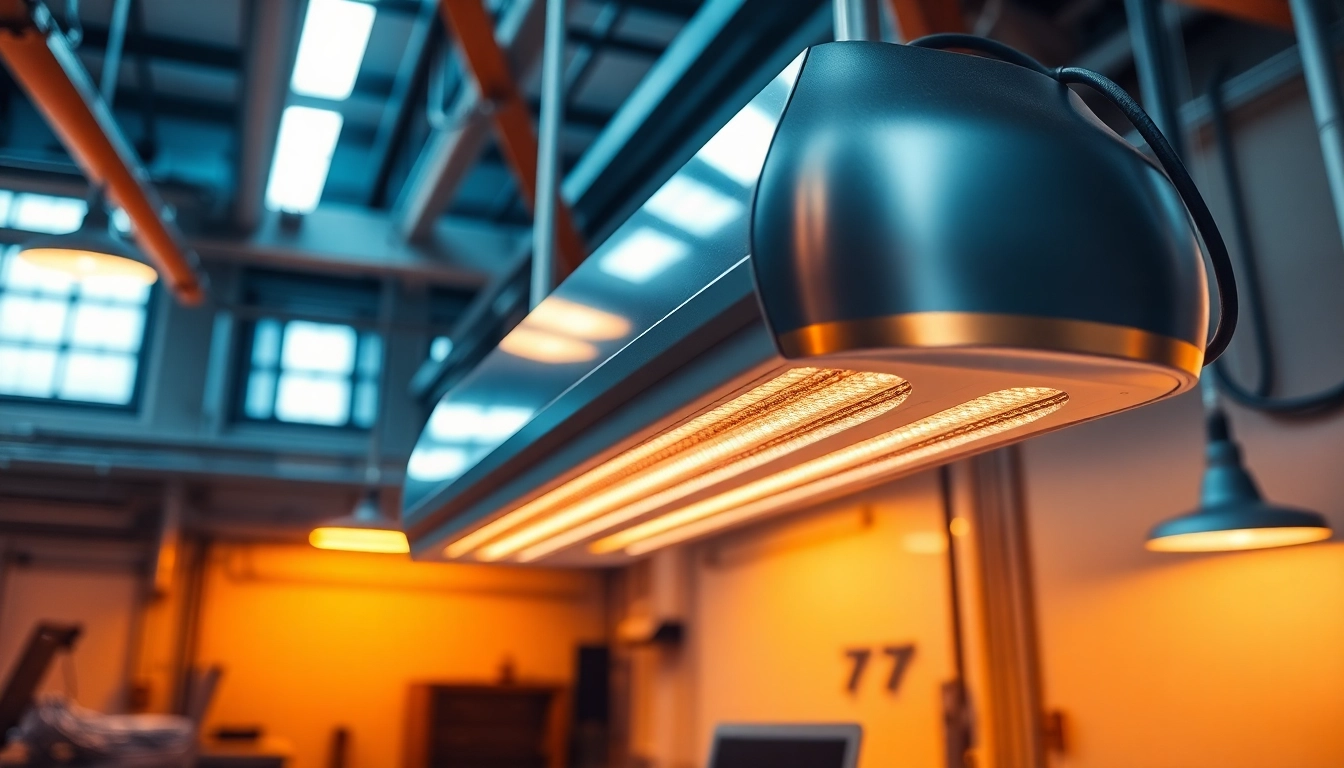Understanding Infrared Heating Technology
What is an Infrared Heating Lamp?
Infrared heating lamps are innovative devices that utilize infrared radiation to deliver heat efficiently and effectively. These lamps emit infrared energy, which is absorbed by objects and surfaces, allowing for rapid heating without heating the surrounding air. This unique technology sets infrared heating apart from traditional heating methods that rely on convection. Infrared heaters are commonly used in various applications, providing a wide range of benefits for both industrial and residential environments.
The infrared heating lamp consists of two main parts: the emitter and the reflector. These emitters are often constructed from high-quality materials, such as quartz, which enhances their durability and efficiency. At Huai’an Yinfrared Heating Technology, we specialize in manufacturing these premium quartz IR emitters, leveraging over 14 years of experience in the industry. Our patented technologies, including gold reflectors and ceramic white coatings, contribute to the higher heating efficiency and targeted heat delivery our clients expect. Discover how our infrared heating lamp solutions can revolutionize your heating processes.
How Infrared Heating Works
Infrared heating works by emitting radiant energy in the form of infrared radiation. This radiation travels through the air and is absorbed by surfaces, generating heat. Unlike traditional heaters that warm the air, infrared heaters directly heat objects and individuals, leading to quicker warmth and improved comfort levels.
The heating process can be divided into three wave types: short, medium, and long wave. Each type has its unique characteristics and applications, making it essential to choose the appropriate one based on specific heating needs.
– Short Wave Infrared (SWIR): These emitters provide high-intensity heat quickly and are ideal for applications requiring immediate warmth or rapid curing processes.
– Medium Wave Infrared (MWIR): This type is commonly used in drying applications, offering a balance between speed and efficiency.
– Long Wave Infrared (LWIR): These emitters are characterized by deeper penetration of heat, making them suitable for applications that require consistent and prolonged heat exposure.
Advantages of Infrared Heating Systems
Infrared heating systems come with a plethora of advantages. First and foremost, energy efficiency is a standout benefit. Infrared heaters can achieve up to 96% energy conversion, which reduces energy waste and lowers fuel costs significantly—by as much as 20% to 50% when compared to traditional heating solutions. This efficiency not only results in cost savings for users but also contributes to a more sustainable approach to heating.
Moreover, infrared heating provides targeted heat, making it ideal for applications requiring precision heating, such as in automotive drying or ink-drying processes for printing businesses. The ability to offer comfortable warmth in various settings, from homes and restaurants to manufacturing facilities, has established infrared heating technology as a go-to solution in numerous industries.
In addition, infrared heating systems can operate silently, enhancing the comfort of indoor environments. They also avoid the circulation of dust and allergens typically caused by conventional heating methods, which can significantly improve air quality.
Applications of Infrared Heating Lamps
Industrial Uses
Infrared heating lamps are extensively used in industrial applications, providing solutions for curing, drying, and heating processes. The automotive industry, for instance, relies on infrared heating technology for drying paint and finishes quickly. The efficiency of infrared heating significantly reduces production time, allowing manufacturers to improve throughput while maintaining high-quality standards.
Additionally, infrared heating lamps are employed in the packaging industry, where they assist in drying and curing inks and adhesives. Their rapid heating capabilities lead to enhanced operational efficiency, making them indispensable in high-speed production environments.
Home and Commercial Spaces
In residential and commercial settings, infrared heating lamps enhance comfort and energy efficiency. These systems can be installed as standalone heaters or integrated into existing HVAC systems. With their ability to provide consistent warmth directly to objects and people, infrared heaters are increasingly favored in restrooms, living areas, kitchens, and even outdoor patio spaces.
Businesses also benefit from infrared heating solutions; restaurants, cafes, and retail spaces utilize these systems to create a warm and inviting atmosphere for customers. Given that infrared heaters operate efficiently, they can help businesses save on heating costs while maintaining sufficient comfort levels for patrons.
Automotive Industry Applications
The automotive industry is one of the pioneers in adopting infrared heating technology for various applications. Specifically, manufacturers utilize infrared heating lamps for drying paint, adhesives, and coatings. By employing infrared systems, these processes accelerate the drying time, allowing for faster vehicle assembly and improved production efficiency.
Additionally, infrared heating is utilized in the curing of automotive components, ensuring quality and performance standards are met. As the automotive sector continues to evolve, integrating advanced infrared heating solutions will play a significant role in meeting the industry’s increasing demands for efficiency and precision.
Choosing the Right Infrared Heating Lamp
Short, Medium, and Long Wave Options
Selecting the appropriate infrared heating lamp involves understanding the distinct characteristics of short, medium, and long wave options. Each type serves different applications and client needs:
– Short Wave: Perfect for rapid heating, ideal for processes that require immediate warmth or specific curing applications.
– Medium Wave: Suitable for drying applications where a balance of speed and energy efficiency is needed.
– Long Wave: Best used for prolonged heating tasks, providing gentle and sustained warmth for various settings.
Understanding your specific heating needs enables you to choose the right type for your application, ensuring optimal performance and efficiency.
Factors to Consider When Selecting
When choosing an infrared heating lamp, several factors need careful consideration:
1. Application Requirements: Determine what you need the heater for—drying, heating, curing, etc. This will guide your selection of short, medium, or long wave options.
2. Space Considerations: Assess the size and layout of the area to be heated, as well as any insulation factors that may influence heating efficiency.
3. Energy Efficiency: Given the importance of cost savings, always evaluate the energy efficiency of the infrared heating system. Choose models that offer the best energy conversion rates.
4. Durability and Maintenance: High-quality materials and design affect the longevity and maintenance needs of infrared heaters. Opt for reputable manufacturers who provide durable products designed for industrial use.
Energy Efficiency and Cost Savings
Energy efficiency is a crucial factor when selecting an infrared heating lamp. Systems that achieve high energy conversion rates not only provide immediate cost benefits but also contribute to sustainability. Lowering energy consumption by 20% to 50% compared to traditional heating methods translates to significant savings over time.
Investing in advanced infrared heating technology can lead to a rapidly noticeable return on investment due to decreased energy bills and improved operational efficiency in any environment, from industrial to residential applications.
Installation and Maintenance Tips
Proper Setup for Optimal Performance
Installing infrared heating lamps requires careful planning and attention to detail. Here are several tips to ensure optimal performance:
1. Placement: Position heaters to provide even coverage and allow for proper circulation. Avoid placing heaters in corners where the heat cannot disperse effectively.
2. Mounting Height: Follow manufacturer guidelines regarding mounting height, as this significantly impacts heating efficiency. Heaters should be installed at the recommended height to ensure maximum efficacy.
3. Distance from Surfaces: Maintain adequate distance between the heater and surfaces to prevent any potential damage from excessive heat.
Routine Maintenance Guidelines
Routine maintenance is essential to keep infrared heating systems running at peak performance. Regular checks should include:
1. Cleaning: Dust and contaminants can hinder performance, so regular cleaning of the heater surface is crucial. Use suitable cleaning agents and avoid abrasive materials.
2. Electrical Checks: Regularly inspect electrical components to ensure they are functioning correctly and safely.
3. Thermal Insulation: Verify that insulation around the heater remains intact to prevent energy loss.
By implementing these maintenance strategies, users can enhance the longevity and efficiency of their infrared heating systems.
Common Issues and Troubleshooting
Despite their reliability, infrared heating systems can encounter issues. Here are common problems and tips for troubleshooting:
1. Insufficient Heat Output: If heaters fail to produce adequate warmth, check for obstructions and ensure heaters are clean and mounted correctly.
2. Inconsistent Heating: Inconsistent performance may result from poor placement or installation. Evaluate the setup to ensure optimal positioning.
3. Electrical Malfunctions: For any signs of electrical issues, such as flickering lights or changes in performance, it’s vital to engage a certified technician for inspection and repair.
Addressing these issues promptly can mitigate potential disruptions and maintain the effectiveness of infrared heating systems.
The Future of Infrared Heating Technology
Innovations in Infrared Heating
The infrared heating industry is continually evolving, with innovations paving the way for increased efficiency and expanded applications. Developments in materials, such as advanced ceramics and better reflector designs, promise to enhance heat distribution and reliability.
In addition, advancements in smart technology allow for sophisticated control systems that optimize energy use. Integrating IoT solutions enables users to monitor heating performance in real time, providing valuable data for better management and efficiency.
Environmental Impact and Sustainability
As awareness of environmental issues grows, the demand for sustainable heating solutions has surged. Infrared heating technology stands out as an eco-friendly option, given its high energy efficiency and reduced carbon footprint. Companies are gradually shifting towards greener alternatives, recognizing that infrared heating provides a viable solution without compromising performance.
The industry’s commitment to sustainability also includes ongoing research and development focused on creating even more efficient heating technologies, ensuring that infrared solutions remain at the forefront of environmentally responsible heating options.
The Growing Market and Demand for Infrared Solutions
As sectors such as manufacturing, automotive, and construction continue to prioritize energy efficiency, the market demand for infrared heating technology is on the rise. The combination of performance, energy savings, and improved comfort supports the increasing adoption of infrared heaters across various industries.
As the market expands, manufacturers like Huai’an Yinfrared Heating Technology play a critical role in meeting demand by offering innovative, high-performance infrared heating lamps and systems. With an emphasis on research and development, we remain dedicated to pushing the boundaries of infrared heating technology.
In conclusion, infrared heating lamps represent a modern solution to heating needs across numerous applications. With their incredible efficiency, targeted heating capabilities, and continuous advancements, infrared heaters are poised to be a staple in both industrial and residential environments for years to come.





Leave a Reply